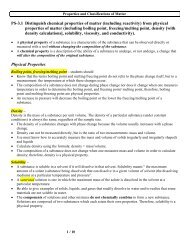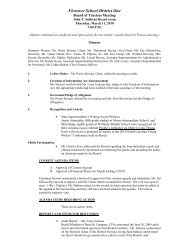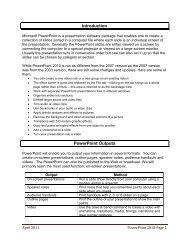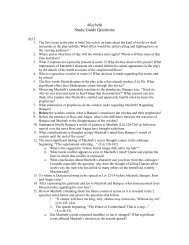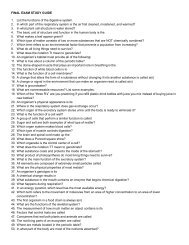Chapter 2: Principles of Ecology
Chapter 2: Principles of Ecology
Chapter 2: Principles of Ecology
You also want an ePaper? Increase the reach of your titles
YUMPU automatically turns print PDFs into web optimized ePapers that Google loves.
Ch. 18 Notes-Part II<br />
Succession<br />
What is succession? Changes over time. Succession can occur in decades or even centuries.<br />
It can take a really long time.<br />
If you didn’t cut the grass, what would happen to it?<br />
1) It would grow larger<br />
2) Weeds would start to grow<br />
3) The area will look like a meadow<br />
4) Bushes will grow<br />
5) Trees will appear<br />
6) Less light will reach the ground b/c<br />
<strong>of</strong> the trees<br />
7) The grass will slowly disappear<br />
8) The area will become a forest<br />
Stages <strong>of</strong> succession<br />
1) Primary succession – colonization <strong>of</strong> new sites by organisms<br />
Example) Lava from a volcano, an avalanche makes new territory for organisms<br />
2) Climax Community – A stable, mature community that undergoes little or no change in<br />
species<br />
3) Secondary succession – sequence <strong>of</strong> community changes that takes place after a<br />
community is disrupted by natural disasters or human actions (occurs in areas that<br />
previously contained life, and on land that contains soil)<br />
Example) Forest fire, hurricanes, farmers abandon a field, a building is demolished<br />
BIOLOGICAL DIVERSITY & CONSERVATION<br />
Biodiversity – variety <strong>of</strong> life in an area (More biodiversity in the warmer environments)<br />
Threatened species-Endangered species-Extinct species<br />
Threats to Biodiversity<br />
1) Habitat loss – when rainforests and coral reefs are wiped out<br />
2) Habitat fragmentation – separation <strong>of</strong> wilderness areas from other wilderness areas<br />
(like islands)<br />
3) Edge effect – when climate is changed along the edge <strong>of</strong> an ecosystem<br />
4) Habitat degradation – damage to a habitat by pollution<br />
5) Introduction <strong>of</strong> exotic animals – introducing a new species into an ecosystem<br />
Conservation biology – new field that studies method and implements plans to protect<br />
biodiversity<br />
How to conserve<br />
1) Legal protection – no one can hunt or kill any animal on the endangered species list<br />
2) Preserving habitats – installing national parks<br />
3) Reintroduction programs – bringing species back to where they once lived<br />
4) Captivity – people holding onto organisms in a zoo<br />
Cycles in nature<br />
There is only a limited amount <strong>of</strong> resources (water, oxygen, nitrogen, carbon) on the earth<br />
In order to keep these resources available to organisms, they must be recycled after they<br />
are used<br />
Cycle: a process that recycles a resource so that you end up with what you started with<br />
6







